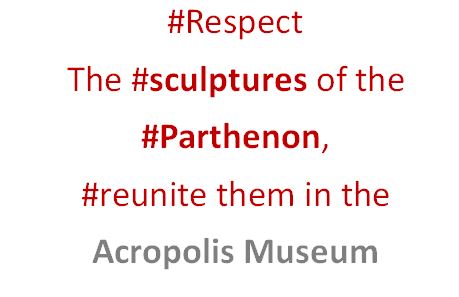PARTHENON SCULPTURES AS EXEMPLARS OF REPRESENTATION OF THE HUMAN BODY
The British Museum plans to break up its collection of sculptures from the Parthenon, albeit temporarily, to illustrate a major but separate exhibition on the development by the ancient Greeks of representation of the human form.
Eddie O'Hara, chairman of the British Committee for the Reunification of the Parthenon Marbles comments: "This blows a hole in the already threadbare justification of the British Museum for their failure to return these sculptures to Athens to be reunified with their counterparts, in some cases literally their over halves of pieces carved from the same block.
The British Museum argues that the Parthenon sculptures are an essential element in their encyclopaedic narrative of world art and culture. There is a specious support for this if the collection is kept together, albeit displayed in a configuration which does little justice to their original disposition on the Parthenon. The BCRPM however has always argued (1) that this collection of sculptures can only make sense in conjunction with the rest of the sculptures in Athens, (2) that the onus of justification is on NOT REUNIFYING them in Athens where they were created and whence they were removed in dubious circumstances, and (3) that in the British Museum's narrative they are MERE EXEMPLARS for which the Greek government has offered to provide alternative exemplars.
Now the BM is preparing to break up the collection to use some of them as, guess what? EXEMPLARS in a totally separate narrative.
Come off it, British Museum. Do the right thing. Do what opinion poll after opinion poll supports. Return to Athens the Parthenon sculptures in your collection. If you do it now the BCRPM is sure that the Greek government will provide you with adequate EXEMPLARS for your new exhibition".
Professor Anthony Snodgrass, Honorary President of BCRPM added:
"No doubt the sculptures will be carefully monitored, for the reaction of the marble to this change in microclimate - an excellent small-scale rehearsal for the much bigger move that they will one day have to make."
ENDS
more coverage in the Guardian ,Telegraph and Greek Reporter
About The British Committee for the Reunification of the Parthenon Marbles (BCRPM)
A group of British people who having considered the case for the reunification of the Parthenon Marbles strongly support it and wish to campaign to achieve it. James Cubitt, a distinguished British architect, met with Melina Mercouri and Jules Dassin before he formed the BCRPM to campaign for the return of the Parthenon Marbles to their rightful home in Athens. The Committee was set up in 1983 under the chairmanship of internationally renowned and universally respected Robert Browning, Emeritus Professor of Greek at the University of London. Then inveterate and accomplished, writer Graham Binns took over as Chairman from 1997-2002, followed 2002-2010 by erudite Professor Anthony Snodgrass, Fellow of the British Academy, Professor Emeritus of Classical Archaeology, University of Cambridge. Currently, former MP Eddie O’Hara has taken on the role. Eddie O’Hara studied Literae Humaniores at Magdalen College, Oxford and has been General Rapporteur for the Cultural Heritage and Museums Rapporteur for the Parliamentary Assembly of the Council of Europe. For more information, visit: www.parthenonuk.com.
International Colloquy for the Reunification of the Parthenon Marbles: London June 2012, Sydney November 2013
Two international Colloquy’s have been organised recently, the first in June 2012 in London, followed by a second in Sydney Australia in November 2013. Both Colloquy’s were organised in conjunction with three campaigning organizations for the Parthenon Marbles, the British Committee for the Reunification of the Parthenon Marbles (BCRPM), the American Committee for the Reunification of the Parthenon Sculptures, Inc. (ACRPS) and the International Organizing Committee – Australia – for the Restitution of the Parthenon Marbles, Inc. (IOC-A-RPM).






Comments powered by CComment